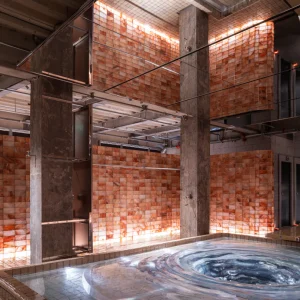The BJC Institute of Health at Washington University School of Medicine will feature Ellen S. Clark Hope Plaza integrated with native landscaping that surrounds the building. Maya Lin has designed the plaza’s landscape and water feature, in collaboration with Massachusetts-based Michael Van Valkenburgh Associates.
The plaza spanning 2.2 acre has been designed to function as a unique front door to the world class medical facility. The plaza has been incorporated to bring lush landscape to the urban campus with trees, grasses and plants native to the St. Louis area chosen in partnership with the Missouri Botanical Garden. About 40,000 plants are placed in the plaza containing 45 Kentucky Coffee trees, 11 American Hornbeam, willows, redbuds and white oak trees. The plaza will also feature up to 10 raised islands filled with local, knee-high grasses and other plants.
Maya Lin has integrated a water feature as the center of attraction at the plaza. The water feature is nearly 80 feet in diameter with a raised platform offering a vantage point to view the landscape. The year-round pool will be watered by a 4,000-gallon reservoir. Due to its disappearing edge, the pool has been dubbed as an ‘infinity pool’. A 38 feet diameter platform equipped with fiber-optic lighting makes the pool look like twinkling stars, when illuminated at night.
The plaza also features seating throughout to create an inviting place of respite, complementing the interiors of the hospitals, clinics and research facilities. The plaza will be accessible from all four directions for emergency vehicles.
Ellen S. Clark Hope Plaza is named after Ellen S. Clark, a longtime donor and friend of the Washington University.
The BJC Institute of Health is an 11-story research building housing laboratories and support facilities for BioMed 21, Washington University’s research initiative to rapidly translate basic research findings into advances in medical treatment.





